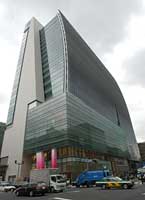|
|
|||||||
|
|
|||||||
|
|||||||
| | Web Japan >>| Trends in Japan >> | Arts & Entertainment >> | Coredo Nihonbashi | |
|
COREDO NIHONBASHI New Development Makes Use of Edo-Period History (November 1, 2004) The year 2004 marks the 401st year since the construction of the Nihonbashi Bridge across the Nihonbashi River in Edo (now Tokyo) by the Tokugawa shogunate. Fittingly, the area enters its fifth century boasting a large, new commercial facility, Coredo Nihonbashi, which opened in March. With the goal of making Nihonbashi the core of "Edo" once again, this commercial center is providing a spark for a redevelopment effort that makes use of long-established shops and historic sites that have characterized this district since the Edo period (1603-1868).
New Tourist Spot Offers Taste of History and Culture Coredo Nihonbashi occupies the first basement through the fourth floor of the glass-lined, 20-story Nihonbashi 1-Chome Building, which stands 120 meters (394 feet) high. Some 8,600 square meters (92,570 square feet) of this space is dedicated to retail shops, and there are a total of 33 eating and drinking establishments, 17 of which have set up shop in Tokyo for the first time or are new types of operations. The goal was not to bring in whatever happened to be trendy at the time but to invite shops that match the image of Nihonbashi as a district of history and traditions. One example of this is the shop Serendipity, which occupies an entire floor of the building. Conceived along the lines of Sony Plaza, an outlet that retails imported knickknacks to a younger clientele, Serendipity offers a range of products for women aged around 35 who have an eye for quality. Though the products are somewhat expensive, they are of impeccable quality and design. The shop is popular among women working in nearby offices. Another shop is an outlet called Garage that is operated by toy-maker Takara Co. Along with toys that have caught the interest of many adult males, this store has on display a Q-Car, a small electric car that can be driven on public roads. Customers can experience what it is like to sit in this car. The types of shoppers who have in the past tended to visit Nihonbashi in the daytime were usually middle-aged and older women. In order to lure nearby office workers and attract families to the area on weekends, most of the restaurants are open until 11:00 on weeknights, and the facility is open for business on weekends and holidays.
A New Tourist Attraction Moves are also underway to make the area a stop for tourists. Metrolink Nihonbashi, a free bus service connecting the Yaesu, Kyobashi, and Nihonbashi areas, began service in March. The buses themselves run on electricity and are very environmentally friendly, and the exterior of the vehicles is decorated with scenes of Edo. The route, which has 12 stops, takes passengers to historic structures that have been designated as important cultural assets, such as the Nihonbashi Bridge, Mitsukoshi, and the Bank of Japan, as well as many old shops that have been in business since the Edo period. Copyright (c) 2004 Web Japan. Edited by Japan Echo Inc. based on domestic Japanese news sources. Articles presented here are offered for reference purposes and do not necessarily represent the policy or views of the Japanese Government. |
CENTRAL TOKYO REBORN (June 19, 2003) TOURING TOKYO (April 18, 2003) GINZA, SHIBUYA GET NEW FACES (October 17, 2001) |
|
|



